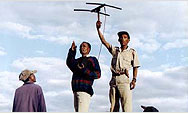 |
 |

 |
 |
Where We Work
Africa
The African continent is home to a large and diverse array of flora and fauna including more than 50,000 known plant species, 1,000 mammal species, and 1,500 bird species. Savannahs, the richest grasslands in the world, are the most extensive ecosystem in Africa. They support the world’s largest concentration of large mammals such as lion, cheetah, zebra, elephants, buffalo, rhinoceros, and giraffes. USAID supports biodiversity conservation programs in 23 African countries.
More information about USAID’s biodiversity conservation in Africa can be found in USAID’s Biodiversity Conservation Report, FY 2004 (4.417MB PDF).
Learn more about USAID’s other environment activities in Africa.
Back to Top ^
Asia and the Near East (including North Africa)
The ANE region is perhaps the most biologically diverse on earth. The region boasts the world’s highest mountain system, the second largest rainforest complex and more than half of the world’s coral reefs. The region’s diverse ecosystems are home to as much as 80 percent of the world’s endangered species. USAID supports biodiversity conservation activities in 14 countries in Asia and the Near East.
More information about USAID’s biodiversity conservation in Asia and the Near East can be found in USAID’s Biodiversity Conservation Report, FY 2004 (4.417MB PDF).
Learn more about USAID’s other environment activities in Asia and the Near East.
Back to Top ^
Europe and Eurasia
The Europe and Eurasia region is home to a wide variety of ecosystems, ranging from the Atlantic coast to the Russian steppes, and from the boreal forest and tundra to Mediterranean forests and shrubland. The region is home to the world’s largest population of bear and rare tigers, and is also an important crossroads for large populations of migratory species shared with Africa, West Asia, and North America. USAID supports biodiversity conservation efforts in three countries in the region.
More information about USAID’s biodiversity conservation in Europe and Eurasia can be found in USAID’s Biodiversity Conservation Report, FY 2004 (4.417MB PDF).
Learn more about USAID’s activities in Europe and Eurasia.
Back to Top ^
Latin America and the Caribbean
From the warm Amazonian valleys, to the high and cold Andean mountains, and from the dry forests of Meso-America to the Pantanal wetlands and the Caribbean coral reefs, the Latin America and Caribbean region is exceptionally rich in biodiversity. The region’s diverse ecosystems are home to 40 percent of the plant and animal species of the planet and are considered to have the highest floristic biodiversity in the world. USAID supports biodiversity conservation efforts in 24 countries in the region.
More information about USAID’s biodiversity conservation in Latin America and the Caribbean can be found in USAID’s Biodiversity Conservation Report, FY 2004 (4.417MB PDF).
Learn more about USAID’s other environment activities in Latin America and the Caribbean.
Back to Top ^
|
|
 |
 |
Tue, 27 Feb 2007 10:29:05 -0500
|
|
 |
 |


